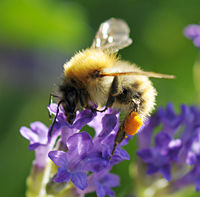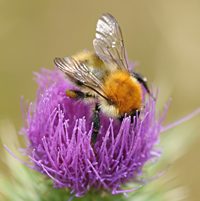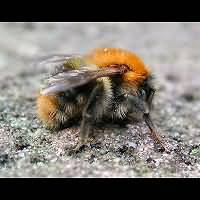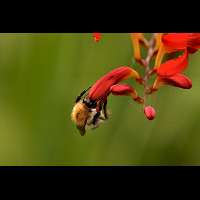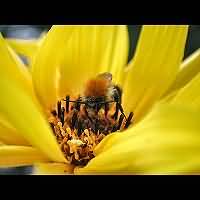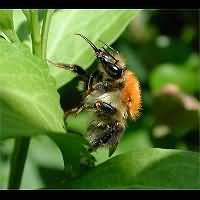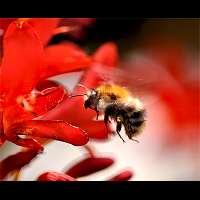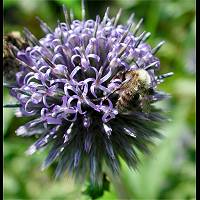[All pictures of garden wildlife on this page are thumbnails. Click on any thumbnail for a large format to be displayed.]
Common Carder Bee (Bombus pascuorum)
There are numerous bumblebee species flying around. And even though many of them have a specific combination of colours, identifying them is not as easy as it seems. Not only do some species look like oneanother, many are extremely variable as well. And queens, workers and males often differ in appearance, complicating matters even more. The Brown Bumblebee also known as Common Carder Bee, is among the easiest to identify. It is one of the smallest species showing a reddish brown tail. Furthermore the entire thorax is covered in brownish yellow hairs, where most species show a band of black hairs as well. The male or drone, shown in the bottom picture, often looks very differently, usually fully covered in whitish hairs.
The Brown Bumblebee is one of the most common bumblebees in Europe, including the British Isles. The size is quite variable. Queens may be up to 18 mm long, reachinh a wingspan of some 32 mm. Workers and drones usually have about the same size: some 12 to 15 mm. In spring however, the first workers may be quite small, sometimes even less than 1 centimeter. The Common Carder Bee has adapted himself to human presence. It does live in woodlands, but prefers parks (even those in big cities), gardens and verges of roads etc. A nest is comprised of some 80 to 100 animals, even though sometimes up to 150 specimens may live in one nest. The Brown Bumblebee is among the friendliest of all bumblebees. As long as you don't put your hand in the nest or squeeze an individual animal, you can even pick it up: it rarely ever stings. It is an opportunist when it comes to places used for nesting. Often an old mousenest will be used, or it builds a nest by itself, usually above the ground. But nests are also found in old bird's nests, nesting boxes, attics or stables.
The Common Carder Bee belongs to a group of bumblebees in possession of a rather long tongue. This group was formerly known as Megabombus pascuorum, for all long-tongued bumblebees were once placed in this genus. Having a long tongue has its advantages of course, because you can reach deeper inside flowers which are bell shaped, like various species of heather. The short tongued bumblebees don't have a problem there either: they simply bite through the flower near the source of the nectar. The queen appears quite early, somewhere around the beginning of April, but never as early as the queens of the Earth Bumblebee or Early Bumblebee. The latter may even appear on mild days in February. Once the queen of the Brown Bumblebee found a good nesting spot, she starts the construction of the nest and collecting the first food storage for the larvae: nectar and pollen. During this initial period she has to keep a good eye on the nest, for else she might find it occupied returning from a flight. Especially the queen of the Shrill Carder Bee is known to take possession of nests under construction. As the Common Carder Bee is not very choosy when it comes to nesting places, she usually finds another spot rather soon.
The Brown Bumblebee is one of the most common bumblebees in Europe, including the British Isles. The size is quite variable. Queens may be up to 18 mm long, reachinh a wingspan of some 32 mm. Workers and drones usually have about the same size: some 12 to 15 mm. In spring however, the first workers may be quite small, sometimes even less than 1 centimeter. The Common Carder Bee has adapted himself to human presence. It does live in woodlands, but prefers parks (even those in big cities), gardens and verges of roads etc. A nest is comprised of some 80 to 100 animals, even though sometimes up to 150 specimens may live in one nest. The Brown Bumblebee is among the friendliest of all bumblebees. As long as you don't put your hand in the nest or squeeze an individual animal, you can even pick it up: it rarely ever stings. It is an opportunist when it comes to places used for nesting. Often an old mousenest will be used, or it builds a nest by itself, usually above the ground. But nests are also found in old bird's nests, nesting boxes, attics or stables.
The Common Carder Bee belongs to a group of bumblebees in possession of a rather long tongue. This group was formerly known as Megabombus pascuorum, for all long-tongued bumblebees were once placed in this genus. Having a long tongue has its advantages of course, because you can reach deeper inside flowers which are bell shaped, like various species of heather. The short tongued bumblebees don't have a problem there either: they simply bite through the flower near the source of the nectar. The queen appears quite early, somewhere around the beginning of April, but never as early as the queens of the Earth Bumblebee or Early Bumblebee. The latter may even appear on mild days in February. Once the queen of the Brown Bumblebee found a good nesting spot, she starts the construction of the nest and collecting the first food storage for the larvae: nectar and pollen. During this initial period she has to keep a good eye on the nest, for else she might find it occupied returning from a flight. Especially the queen of the Shrill Carder Bee is known to take possession of nests under construction. As the Common Carder Bee is not very choosy when it comes to nesting places, she usually finds another spot rather soon.

© Copyright 1998-2024 gardensafari.net (Hania Berdys)

 English / engels
English / engels  Dutch / nederlands
Dutch / nederlands